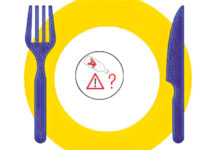The Food and Drug Administration (FDA) took action against the giant Bimbo Bakeries – the largest US bakery industry group– to contest the misuse of precautionary labelling claims about the possible presence of allergens (‘it may contain…). (1)
1) FDA, investigations on Bimbo Bakeries
FDA and the Department of Agriculture inspectors conducted inspections at Bimbo Bakeries facilities in Phoenix, Arizona, and Topeka, Kansas, between October and November 2023.
The labels verification, as part of official controls, revealed ‘serious violations of the Federal Food, Drug, and Cosmetic Act’ and applicable regulations.
2) Allergens, abuses of ‘contain’ and ‘may contain’
The labels of a number of ready-to-eat (RTE) products – ‘Sara Lee’ brand sliced breads (Artesano Brioche, Delightful Multigrain, Artesano Golden Wheat and Artesano Smooth Multigrain) – ‘are false or misleading,’ according to FDA, because:
–‘include sesame seeds in the ingredients and ‘Contains’ statements [allergens, ed.]; and yet,
–‘sesame seeds are not an ingredient in the product formulations’.
Another Brownberry brand ready-to-eat bread’s label (Whole Grains 12 Grains and Seeds) is also incorrect as it refers to ‘walnuts, almonds and hazelnuts’ – among the ingredients and the ‘contains’ declarations – without them being present in the product formulations.
3) Khorasan wheat, not Kamut
Another violation of the law detected by FDA is the reference in the ingredients list to ‘Kamut®’ – which is simply a registered trademark – rather than to khorasan wheat which expresses its botanical variety.
‘Wheat (including spelt and khorasan wheat), rye, barley, oats or their hybridized strains and derived products’ must always be reffered to by their respective names, even in the European Union as seen. (2)
4) Good manufacturing practices and risk of contamination with allergens
‘FDA expects food manufacturers tomfollow good manufacturing practices and implement preventative controls to prevent the inadvertent incorporation of allergens into foods that are not formulated to contain them.
Labeling is not a substitute for adherence to good manufacturing practices or implementation of preventative controls. Instead, companies must comply with applicable requirements to address cross-contact with allergens.’(1)
5) Accidental contamination and labelling
Food business operators, FDA continues:
–‘may decide to voluntarily place allergen warning statements on products to alert consumers to the possible presence of major food allergens due to cross-contact’.
-nevertheless, ‘any allergen warning statement must be truthful and not misleading.’ (1)
6) PAL (Precautionary Allergens Labeling)
Voluntary precautionary labelling (PAL, Precautionary Allergens Labeling) – as has been discussed for at least six years in the Codex Alimentarius (3) – can therefore be included on the label on condition of a scrupulous risk analysis that reveals:
-the actual risk of contamination of the single food product with one or more of the individual allergen proteins subject to mandatory indication (4,5);
-the impossibility of excluding such risk, despite the application of GMPs (Good Manufacturing Practices) in the plant and production line concerned.
7) Tolerance thresholds, the unsolved problem
The unsolved problem– in the USA, as in the EU–remains the definition of thresholds (Reference doses) below which, following specific analyses on finished products, ithe risk of adverse reactions by allergic consumers can be excluded (6,7).
The FDA itself, when referring to possible allergen residues in food products, mentions the idea of ’insignificant quantities’. The definition of which is however indispensable for both food labelling and the management of any food safety risks.
Dario Dongo
Footnotes
(1) FDA warning letter to Bimbo Bakeries USA, Inc. June 17, 2024 https://t.ly/7dAHV
(2) Dario Dongo. Allergens, spelled wheat or wheat? GIFT (Great Italian Food Trade). 28.2.19
(3) Dario Dongo. Food Allergies and PAL, Codex Alimentarius. GIFT (Great Italian Food Trade). 28.11.18
(4) The allergens subject to mandatory specific information, in the European Union, are indicated in Annex II to the Food Information Regulation (EU) No 1169/11.
(5) Food Allergens – International Regulatory Chart https://farrp.unl.edu/IRChart
(6) See paragraph 4 (Food allergies, essential solutions) in the previous article by Dario Dongo. FDA tests milk allergen in US chocolate. GIFT (Great Italian Food Trade). 18.9.24
(7) Dario Dongo. Allergens and RASFF, European blackout. GIFT (Great Italian Food Trade). 13.7.22
Dario Dongo, lawyer and journalist, PhD in international food law, founder of WIISE (FARE - GIFT - Food Times) and Égalité.








